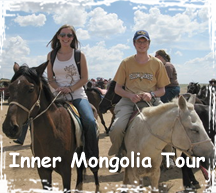Top 10 Things to Do in Inner Mongolia (around Hohhot)
Inner Mongolia is situated on China's northernmost tip boarding Mongolia and Russia for 4200km. The Inner Mongolia Autonomous Region is largely inhabited by the Mongolians, with grasslands, deserts, forests, and the Yellow River.Its long history and unique culture provide a rich resource for local tourism industry which boasts pastureland, national folklore, horse and camel riding, adventures on foot etc. Apart from Tibet, Inner Mongolia is another exotic place in China. You can find the vast grasslands, the Gobi desert, spectacular Naadam festival, the relics of Genghis Khan's and the Mongolian way of life.
| Choose your favorite top 10 things to do in Inner Mongolia |
1. Extending yourself on the mesmerizing Grasslands
There are many beautiful pastures in Inner Mongolia. The most popular are Gegentala Grassland in Ulanqab, Xilamuren Grassland in Baotou and Huitengxile Grassland in Hohhot; Ordos Grassland in Hanggig Qi, Ordos; Jinlianchuan Grassland in Zhenglanqi, Xilin Gol.
Gegentala Grassland (Siziwan Banner, Ulanqab) - 140 km north of Hohhot. Gegentala means "a place for spending summer" in Mongolian. Gegentala Grassland lies in Siziwang Banner, the Ulanqub City. This pasture offers people a place to appreciate the beautiful scenery of the grassland, go to the herdsman's family as guests and learn the customs and manners of the Mongolian people living on the grassland north of the Great Wall. The visitors have an opportunity to run on the horseback or go slowly on the back of camels. In addition, visitors can take the ox carts, practice archery and watch the Mongolian-style wrestling and horse racing. In the evening, they can attend the bonfire evening party, singing and dancing with the local performers.
Xilamuren Steppe (Darhan Muminggan United Banner in Baotou) - 100km northwest of Hohhot. Xilamuren literally means "yellow river" in Mongolian. Xilamuren Grassland is teemed by green grass and fresh flowers every summer and autumn. Thanks to to the continual efforts made by the local government, the service quality is becoming better and better. As result, Xilamuren has been turned into one of the must visit pastures in Inner Mongolia after Gegentala Grassland and Huitengxila Grassland. It is advisable to spend a night or two out here in a Mongolian traditional tent (yurt). You may take part in or just enjoy many activities such as Mongolian wrestling, horse and camel riding, rodeo competitions, archery, visiting traditional families, and make short trips to the aobaos (rock mounds that are often festooned with flags for worship).
Huitengxile Grassland (Chahar Right Middle Banner in Ulanqab) - 135km northeast of Hohhot. It literally means "cold Plateau" since it is located at an altitude of over 1800 meters, extending over 100 kilometers from east to west, dotted with 99 lakes. It is the less spoiled and touristy grassland with relatively greener grass. But the yurt facilities here are not as good as in Gegentala or Xilamuren Grasslands.
Every June through September, Hutengxile becomes the sea of flowers. Tourists can enjoy their stay here riding on horseback, archery, watching wrestling, and joining in singing and dancing in the open air.
Ordos Grassland (Hanggig Banner, Ordos ) - The Ordos Grassland is located 12 kilometers west of Hanggin Banner in Ordos, 430km west of Hohhot. The grassland, with and area of 600 square kilometers, consists of over 100 Mongolia yurts. The whole grassland is divided into song and dance area, entertainment area, accommodation area, fete area, Mongolian folk area and so on. You also have the chance to take part in the traditional activities of Mongolia such as wrestling, horse riding, toxophily etc. The green grass wafts under the blue sky, and white sheep hides among the grass, appearing while wind blowing.
The Ordos Grassland is like hovering lannerets always with warm greeting to the friends from all corners of the world.
Jinlianchuan Prairie (Zhenglan Qi, Xilin Gol) - 20km east of Zhenglan Qi ( Plain Blue Banner ) in Xilin Gol, 580km northeast of Hohhot. It is a part of Xilin Gol Prairie. There are two main seasons to visit this grassland - there are yellow flowers and many other kinds of unknown flowers all over the mountains and plains Here and you also can visit the site of the Yuan Dynasty Upper Capital which is located on the north bank of Upper Capital River in Plain Blue Banner. The Jinlianchuan Prairie is the most beautiful grassland in Inner Mongolia. It is rich in edible and medicinal plants such as the fern, day lily. Here is also the authentic capital site for the Yuan Dynasty and an important epitome of the nomadic civilization of the 13th and 14th Century.
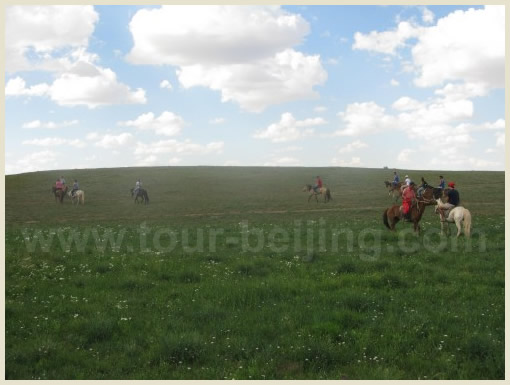
2. Following the trails of Genghis Khan and Kublai Khan
Genghis Khan’s Mausoleum (Ejin Horo Banner, Ordos) - Genghis Khan is a Mongolian hero who reunified the chaotic Inner-Mongolia prairie, made great contribution to the founding of the powerful Yuan Dynasty and enhanced greatly the interaction of the people of China. Until today, Genghis Khan is still worshipped by people for his great feat. After Genghis Khan died, his coffin was carried to central Mongolia. According to his will, he was buried without any markings, so the real mausoleum is still a puzzle. However, whether it is true or not, the mausoleum in Inner-Mongolia remains a sacred place with great significance for Mongolian people.
The site of the Yuan Dynasty Upper Capital (Shangdu or Xanadu in Zhenglan Banner in Xilin Gol) - In 1260, Yuan Shizu Emperor Kublai Khan, grandson of Genghis Khan, estabished the capital at Upper Capital, about 20km east of Plain Blue Banner in Ulanqab. When the Yuan Dadu Capital was founded at Yanjing (present Beijing City) in the year of 1264, the imperial syste of inspection tour between the two capitals was formed. Upper Capital and Dadu (Grand Capital) became two alternate capitals for the Great Yuan Dynasty, spanning the 108-year reign of 11 emperors in succession. In this period the Yuan empire controlled a vast territory and thrived, becoming a great power and ushering the new era of the Chinese ancient history and the world history of nomadic nations. Marco Polo, his father and uncle arrived in Shangdu (Xanadu), in 1275 when Marco Polo was at the age of 21. Marco Polo met Kublai Khan soon after arriving in Shangdu.
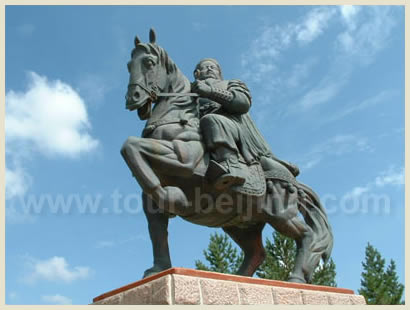
3. Rewinding yourself on the Sand and Gobi
Inner Mongolia has several large deserts, some of which stretch into the neighboring Qinghai and Xinjiang provinces as well as into the bordering state of Mongolia. The largest one is the Badain Jaran Desert. In terms of accessibilty from the two big cities Hohhot and Baotou, the Kubuqi Desert is the one that is most easily accessible to tourists. Kubuqi Desert is 7th biggest desert in China and it ranks the third place in Inner Mongolia.
Resonant Sand Gorge ( Dalat Banner, Ordos) - Baotou offers an easy access for travellers who want to travel the Gobi desert. The nearest and most accessible part of the Gobi and desert is a sand dune filled gorge called Resonant Sand Gorge, about 60 kilometres south of Baotou within the administration of Dalat Banner in Ordos. The resonant sand gorge, meaning “dune with bugle” in Mongolian, lies to the north edge of the Kubuqi Desert with 400 meters wide and 110 meters high. There are no roads or towns in Gobi. It consists primarily of endless stretches of gravel and grasslands. Travelers are mostly members of organized tours and hire a vehicle with a driver.
Qixinghu Desert Eco-Tourism Resort (Hanggig Banner, Ordos) - Qixinghu means "Seven Star Lake" which is hidden in the vastness of Qubuqi Desert. Seven mirror-like lakes are arranged in order, spreading like a big dipper. Seven Star Lake Desert Eco-Tourism Resort is a theme of ecological construction in the desert. Water activities include motorboat, yachts, boats, water bikes, fishing, etc., the sand activities cover sand sliding, paragliding, hot air balloon, sand volleyball, sand football, horse riding, camel. In August 2007, International Year of Deserts Kubuqi Forum" was held. I addition, Seven Star Lake is chosen as a permanent venue. Now the International Kubuqi Desert Forum will become an annul meeting, more and more attention from state and government.
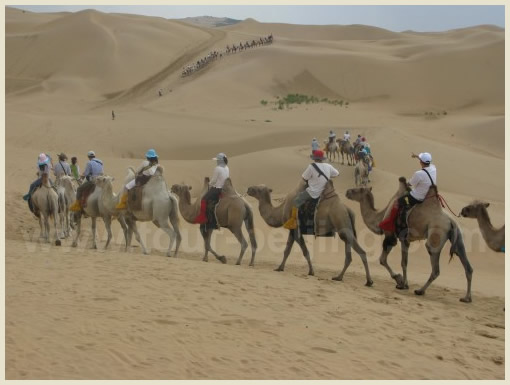
4. Visiting the lamaseries and temples
The Five Pagoda Temple (Hohhot) - an important Tibetan Buddhist temple, which has been viewed as the symbol of Inner Mongolian now. As there are five small dagbas on the pedestal of the pagoda, it is named Wuta Si, that is Five Pagoda Temple.
Dazhao Monastery (Hohhot) - Dazhao Monastery, to the east of Xilitu Zhao, is the largest and best preserved monastery in Hohhot, Inner Mongolia province. Dazhao means “Wu Liang” in Chinese and “Grand Monastery” in Mongolian. It was built firstly in Ming Dynasty, and rebuilt in Qing Dynasty, in 1640 year. Dazhao Monastery is the first Lama monastery in Hohhot. For hundreds of years, it has been considered as a religious center for people from all over Mongolia.
Wudangzhao Lamasery (Darhan Muminggan United Banner, Baltou) - Situated 70km to the northeast of Baotou, the old Lamasery is the largest of its kind in western Inner Mongolia with a history of over 250 years. The Yellow Hat Sect (Gelukpa) is popularly practiced here. The Lamasery is named Wudangzhao, literally Willow Lamasery in Mongolian, because the area around the temple has long been covered by these wispy trees. Wudangzhao was built in 1749 during the Qing Dynasty and under the reign of Kangxi. Lamasery.
Meidai Lamasery (Tumed Right Banner, Baotou)- 80km east of Baotou on the way from Hohhot to Baotou. It was originally built by Longqing Emperor Altan Khan, chief of Tumd Mongolian Tribe of the Ming Dynasty (1368 - 1644). Actually the Lamasery is the blend of a town and a temple. This was also the place where Alatan introduced the Tibetan Buddhism into Inner Mongolia. The Meidai Lamasery is a symbol of the unity of multi nationalities and an important historical relic under the state protection. This is of great value to the study of the Mongolian history and architecture of the Ming Dynasty.
Huizong Temple(Duolun, Xilin Gol) - Huizong Temple was originally built in Duolun by the Kangxi emperor in 1711, and it was staffed by monks from the 120 banners of Mongolia. In the past Duolun (Dolonnor) was also nicknamed " Lama miao", or "Lama temple," named after the many temples located there. One of the two famous temples is Huizong Temple ( Koke Monastery ). It was in Dolonnor, in 1691, that Zanabazar, the first Bogdo Gegen of Urga, escorted by the princes of the Khalkha, met with the Kangxi emperor ( who reigned from 1662 to 1722) in Qing Dynsty and recognized his suzerainty. As a result, many important monasteries were founded there with imperial patronage, and Duolun became a most important center of Mongolian Buddhism in southern Mongolia.
Now, here the weathered vermillion buildings are stark and simple. Among the Tibetan elements are tall prayer wheels in the entryway and a parti-colored strip of prayer flags running the breath of the courtyard.
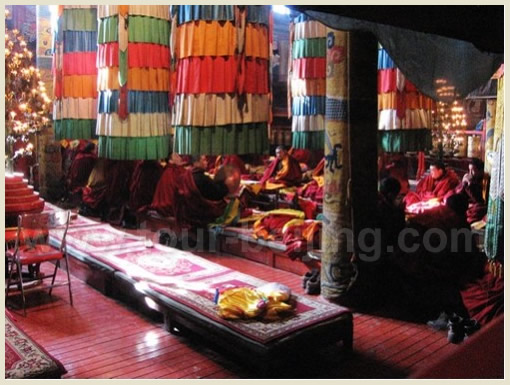
5. Visiting local museums
Jiangjun Yashu at Suiyuan City (Hohhot) - During the Qing Dynasty (1644 -1911), in order to consolidate the northwest boarder and the Hohhot city, Qing Dynasty ordered to build new town called Suiyuan city. Jiangjun Yashu, built for the general of the Suiyuan city, covers an area of 15,000 square meters. In front of the gate, there is a tall screen wall and tow stone lions stand on each side of the gate. In the courtyard, there are 3 architectures. The middle one is the main hall, surrounded by the two house named Wutang. After the hall is the Gongxie (named government office in an ancient year). And the backyard is the general’s private residence.
Inner Mongolia Museum ( Hohhot) - It is located in the heart of Hohhot. It is the largest and best museum in the Inner Mongolia Autonomous Region. It has an area of 3,500 square meters with four parts - Ancient Biology, Historical Relics, Folk Custom, and Modern Relics, displaying the natural landscapes and social development of Inner Mongolia. Inner Mongolia Museum was established on the occasion of the tenth anniversary of the establishment of the Inner Mongolia Autonomous Region in 1957. The Inner Mongolia Museum holds 44,000 objects relating to ethnic history in its collections. Among these quite a few are rare treasures seldom seen in China, especially the artifacts relating to the northern tribes called Xiongnu, Xianbei, Qidan, Mongolians and others.
Erlian Basin Dinosaur Museum (Erlianhot) - The Erlian Basin Dinosaur Museum is located close to the archaeological dig site. Over ten dinosaur species have been found in this area. They are believed to be the remains of a gigantic, surprisingly bird-like dinosaur, which has been classed as a new species and genus, now named Gigantoraptor erlianensis. The dinosaur statues set against the remote setting makes people thining back to the Mongolia of 65 million years ago and believing birds likely evolved from dinosaurs.
Shangdu Museum (Zhenglan Qi, or Plain Blue Banner) - The only museum in Zhenglan Qi in Xilin Gol. It was founded by Inner Mongolia Jitai Group in 2008. The museum covers an area of 9900 square meters, construction area of 3,000 square meters. It is a two-story building, with four exhibition halls, a video room, the antiques room and arts & crafts sections. The museum is focused on the Yuan Dynasty culture, Shangdu and the Char folklore as well as Zhenglan Qi as the main body. The museum has a rich collection of valuable antiques in Yuan Dynasty in addition to the collections from local government and the Inner Mongolia Association of antiques and artifacts.
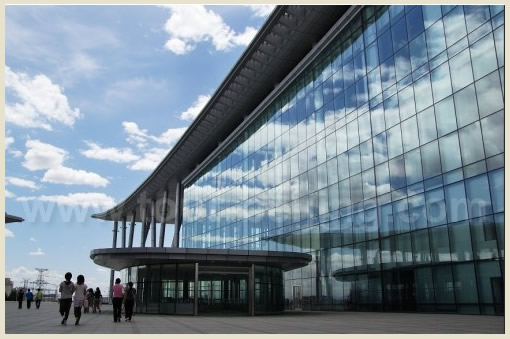
6. Experiencing Traditional Nadam Fair
Nadam literally means "entertainment and games," in Mongolian. Archery, horse racing and wrestling are the fixed sports items in the Nadam Fair. Later the three sports items are shortened as "Nadam" by the Mongolians. Nadam Festial has a tradition of over 700 years. which can be traced back to the initial stage of the Mongol Empire. In order to pray for and celebrate a good harvest as well as inspect the army, Genghis Khan held annual gathering of clan leaders and organized contests of shooting, horse racing or wrestling. By the late Qing Dynasty, the Nadam Fair had evolved into a recreational activity which was regularly held by the government. Now each yearNadam Fair will be held in Gegentala Grassland in late July.
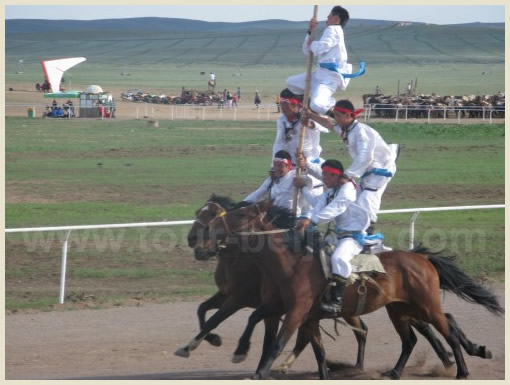
7. Enjoying Mongolian Food
For its geography position and habitation, the cuisine in Inner Mongolia features the venison. The Mongolia prairie is rich in all kinds of venison such as wild chicken, potherb, wild fungus and so on. The most outstanding cates are Baked whole sheep, Baked Gigot, Hand-tore Mutton, Ghee,Kumiss etc. While eating the meat, you could taste its kumiss, surely the flavor will be a long aftertaste.
Roasted Whole Sheep
It is the traditional cuisine to entertain the honoured guest or to celebrate the grand pageant in Mongolia. The sheep is selected aboratively, about 20 kilogramme each one. The whole shape is dressed, stuffed with seasonings such as shallot, ginger, salt, etc., then baked. The cuisine keeps the complete shape of the sheep, kneeled down in a square trencher, and is prized for the fresh color, crispy skin, and tender, aromatic meat.
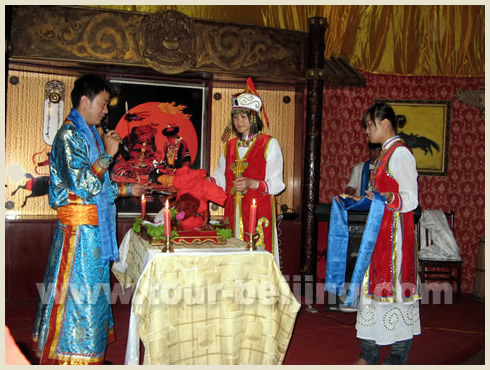
8. Experiencing Horse and camel riding
Each grasslands offer horse riding activity. Going to the stud form to select the horse for horseback riding. Usually the cost for horseback riding is not included in the tour package. The herdsman in charge tells you the cost for horse riding - RMB 150 per round per person including the horse riding, visiting Aobao and a herdsmen's family, which usually takes about 2-3 hours. The horseback is the hightlight of the Inner Mongolia tour. So everyone chooses the grassland activity - riding a horse.
For most of people, experiencing the camel riding is exciting. Lining up camel by camel, a team of about 10 camels walking together. Camel riding is more comfortable and safer than ridng a horse. The one hour camel riding takes you to another sand hill top, then return where we start.
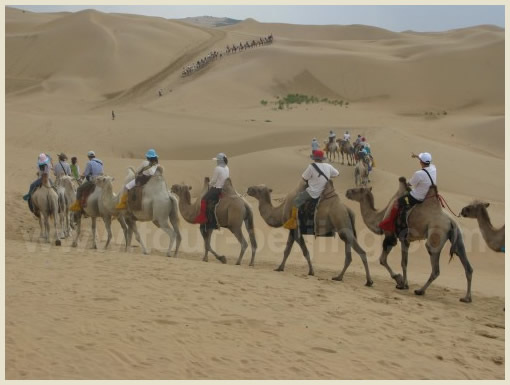
9. Staying in Yurts
There are three kinds of yurts at most of the tourist grasslands in Inner Mongolia - normal traditional yurts, deluxe yurts and war chariot yurts.
Normal traditional yurts - These kinds of yurts are simple, more in traditional Mongolian style. It is made of hide supported by rod and easily taken apart. But it doesn't offer bath and toilet facitlities. So for those who stay in a traditional yurt, they have to use the public toilet and bath room, a little unconvenient for modern people. But still many people prefer these kinds of yurts as a kind of traditional grassland experience.
Deluxe Yurts - Deluxe yurts have almost the same fuctions and facilities as hotels. They look like yurt outside. But inside the yurts, they are just like the standard rooms of hotels - washing room, bath room, tea tabble, desk and more.
War chariot yurts - Genghis Khan conducted an aggressive foreign policy by having the Mongol invasions of East and Central Asia. In his life, the Mongol Empire finally occupied most of Asia. War chariot yurts were one his powerful weapons to overpass his counterparts. They were fast, mobile. They also have the same fuctions and facilities as hotels - washing room, bath room, tea tabble, desk and more.
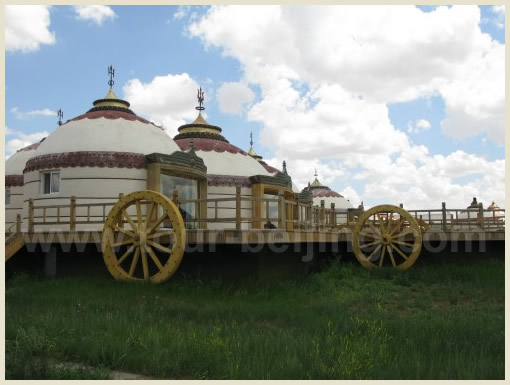
10. Shopping for exotic things
The strong folk flavor of Inner-Mongolia gives birth to various unique specialties including the silverwares, carpet, Mongolian knife, horse head string instrument, ox horn handcrafts, cashmere and so on. If you are interested in these handcrafts, the local bazaar, or market will be ideal places. Inner Mongolia Antique Shop on Xilin Road, in Hohhot city. Cashmere is a rare raw material for textile. Cashmere from Inner Mongolia is world famous. So is camel hair, which can be made into woolen cloth and carpet. Mongolian Knife is the daily products and also the baldric of the Mongolian man. A man without his knife will be looked down.
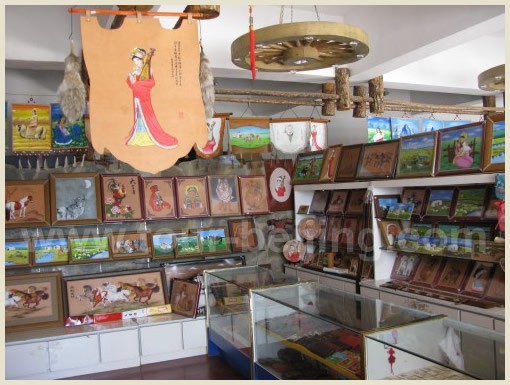
----------------------------------------------------------------------------------------------------
Xishan Bay Scenic Area
Xishan Bay Scenic Area is located 30km southeast of Duolun County. The provincial-level road No.308 leads directly to the scenic area. Xishan Bay Reservoir has the water surface area of 20,000 Chinese acres with storage capacity 100,000,000 cubic meters. Its natural landscape is richly colorful with four distinctive seasons.
The scenes along the banks coupled by the lake island in the reservoir and the peninsula, the sand peninsula and the mountain, the water, the sand, the grass combined constitute a three-dimensional picture scroll.
It is also the headstream of the Luanhe River and the Miyun Reservoir in Tianjin and Beijing. The Xishan bay drift at the headstream is the amusement area which forms by a natural river course. The river water is clear enough to see bottom. When you lie supine when the raft excursion goes heartily slowly with the blue sky and white clouds, you will feel that you have returned to the nature with pleasure.
There is a man made sections of the Great Wall - so called "Badaling Great Wall" built on the site of the Great Wall resembling the Badaling Great Wall in Beijing. Ascend the wall and have a bird-eye view of the beautiful scenery with the reservoir water, grass and hills combined
Questions & Answers:

